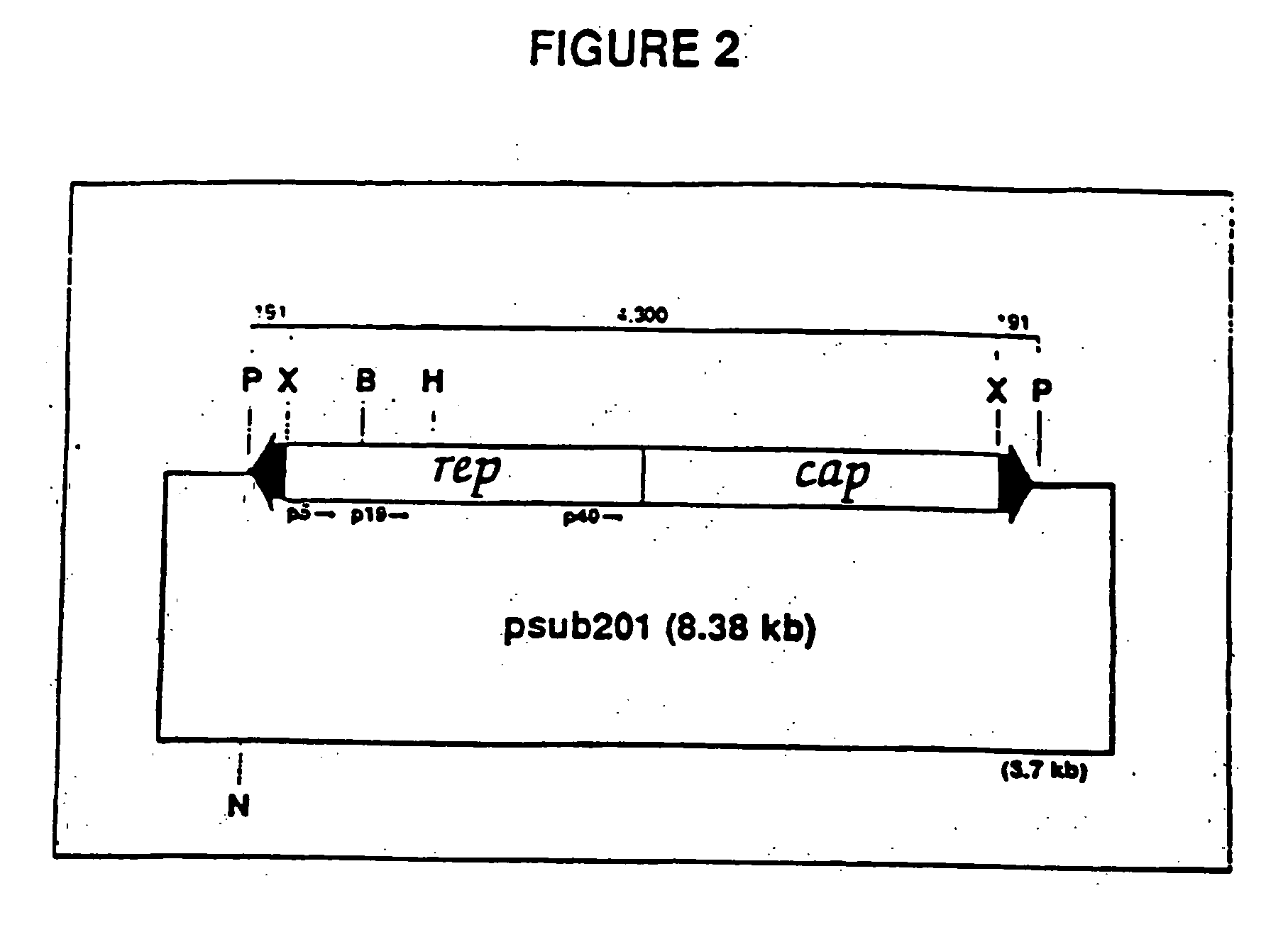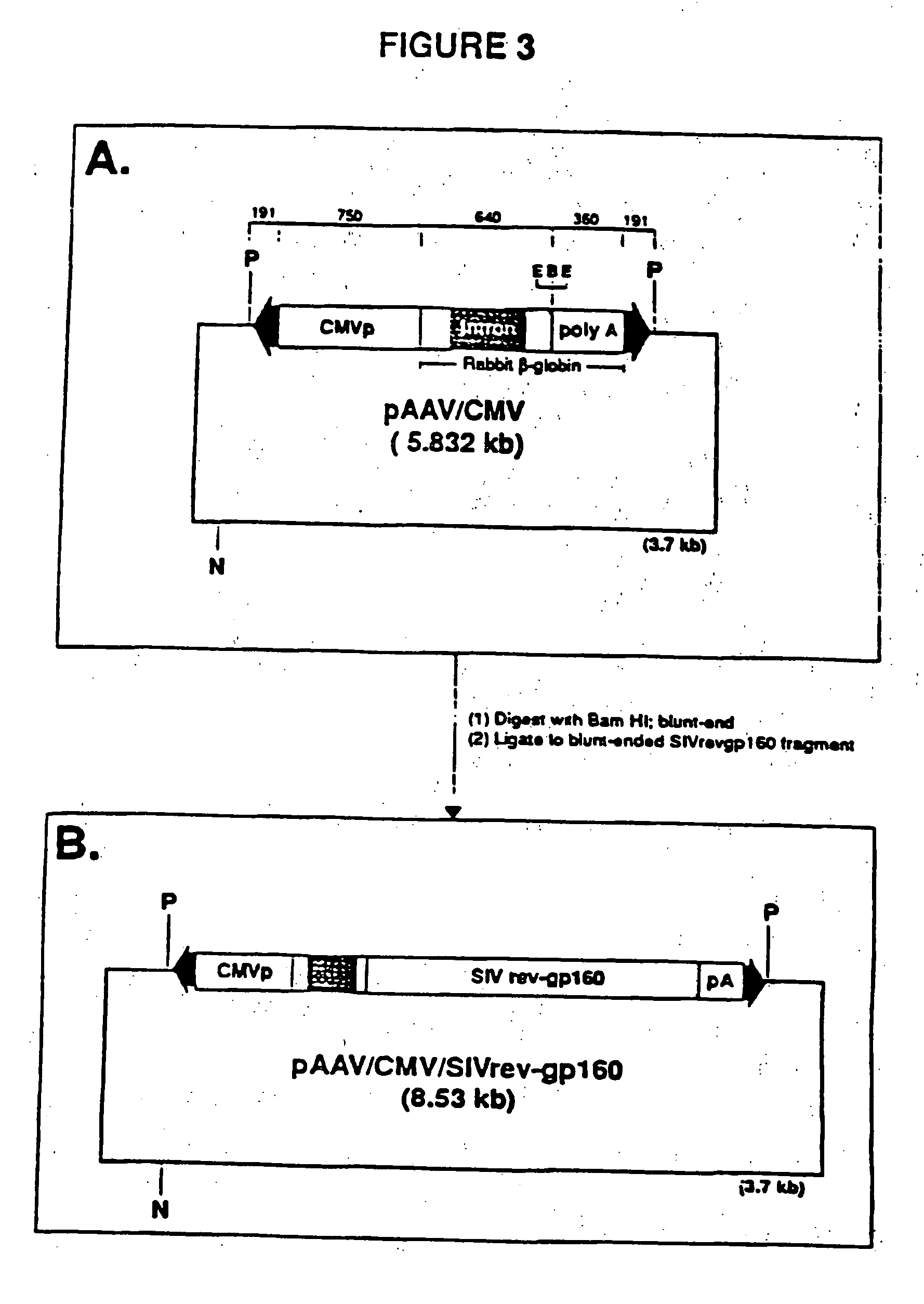Adeno-associated virus materials and methods
a technology of adenovirus and materials, applied in the field of adenovirus materials and methods, can solve the problems of lack of highly efficient schemes for encapitating recombinant genomes, inability to resist superinfection of aav-infected cells, and inability to provide long-lasting immune responses through direct dna inoculation
- Summary
- Abstract
- Description
- Claims
- Application Information
AI Technical Summary
Benefits of technology
Problems solved by technology
Method used
Image
Examples
example 1
[0024] A vector including a rAAV genome containing a SIV rev and envelope (gp160) gene cassette was constructed from an existing plasmid designated psub201 [Samulski et al., supra]. FIG. 2 is a diagram of plasmid .psub201 wherein restriction endonuclease sites are shown and abbreviated as follows: P. PvuII; X, XbaI; B, BamHI; H,. HindIII; and N, NaeI. The plasmid contains a modified wild-type AAV2 genome cloned between the PvuII restriction sites. The DNA sequence of the wild-type AAV2 genome is set out in SEQ ID NO: 1. The AAV2 sequence was modified to include convenient restriction sites. Specifically, two XbaI restriction sites were added via linker addition at sequence positions 190 and 4484. These sites are internal to 191 bp inverted terminal repeats (ITRs) which included the 145 bp ITRs of the AAV genome. The insertion of these sites allows the complete removal of the internal 4.3 kb fragment containing the AAV rep-cap genes upon XbaI digestion of the plasmid. In FIG. 2, the ...
example 2
[0029] A plasmid designated pSV40 / neo / rep-cap which contains the AAV rep-cap genes and a neomycin resistance gene- was constructed to be used in conjunction with the rAAV genome vector described in Example 1 to generate a stable cell line producing rAAV.
[0030] A plasmid designated pAAV / SVneo (Samulski et al., supra) was digested with EcoRI and BamHI to release a 2.7 kb insert including a 421 bp portion of the SV40 early promoter, a 1.4 kb neomycin resistance gene, and a 852 bp DNA fragment containing the SV40 small t splice site and SV40 polyadenylation signal. This released insert was cloned into the EcoRI and BamHI sites of pBLUESCRIPT KS+ (Stratagene, La Jolla, Calif.) to generate the 5.66 kb plasmid pSV40 / neo. Next, the approximately 4.3 kb DNA fragment containing the AAV cap genes, derived from the digestion of psub201 with XbaI as described in Example 1, was ligated into the XbaI restriction site of pSV40 / neo to create the plasmid pSV40 / neo / rcap (about 10 kb). The constructio...
example 3
[0031] A final vector to be used to generate stable cell lines producing rAAV was generated from vector pAAWCMV / SIVrev-gp160 (Example 1) and plasmid pSV40 / neo / rpsa (Example 2).
[0032] The construction entailed removing the neo-rep-cap gene cassette from pSV40 / neo / rep-cap and inserting it into a unique NaeI site in pAAV / CMV / SiVrev-gp160 (see FIG. 3B); Specifically, vector pAAV / CMV / SIVrev-gp160 / neo / repa was made by agarose gel band isolating a 7.0 kb EcoRV-Nod DNA fragment containing the SV / neo and rep-cap expression domains from pSV40 / neo / cap. The sticky ends of the fragment were blunted with Kienow and the fragment was ligated into the blunt-ended NaeI site of pAAVWCMV / SIVrev-gp160. See FIG. 4. Voctor pAAV / CMV / SIVrev-gp160 / neo / repcap (ATCC 69637) contains the following elements: (1) the RAAV genome; (2) AAV Cap genes; and (3) the neomycin resistance gene.
PUM
 Login to View More
Login to View More Abstract
Description
Claims
Application Information
 Login to View More
Login to View More - R&D
- Intellectual Property
- Life Sciences
- Materials
- Tech Scout
- Unparalleled Data Quality
- Higher Quality Content
- 60% Fewer Hallucinations
Browse by: Latest US Patents, China's latest patents, Technical Efficacy Thesaurus, Application Domain, Technology Topic, Popular Technical Reports.
© 2025 PatSnap. All rights reserved.Legal|Privacy policy|Modern Slavery Act Transparency Statement|Sitemap|About US| Contact US: help@patsnap.com



